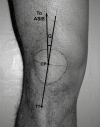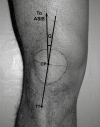Bilateral Variability of the Quadriceps Angle (Q angle) in an Adult Indian Population
- PMID: 23493777
- PMCID: PMC3586842
Bilateral Variability of the Quadriceps Angle (Q angle) in an Adult Indian Population
Abstract
Objectives: The objective of this study was to document and explain bilateral differences in the Q angle.
Materials and methods: Two hundred limbs of healthy adult Indian volunteers were studied. The Q angle was measured using a goniometric method with the subjects supine, quadriceps relaxed and lower limbs in neutral rotation. The relative lateral placement of the tibial tuberosity with respect to the centre of the patella was measured. Appropriate statistical tests were used to determine the bilateral variability in the Q angle and the lateral placement of the tibial tuberosity. Inter-observer variation of the above mentioned parameters were studied in twenty limbs.
Results: The average Q angle value of all the 200 limbs was 12.73 °C; the mean value on the right was 12.86 °C and 12.60 °C on the left. When the Q angle and the lateral placement of the tibial tuberosity were considered in pairs a significant difference was noted in males. The Q angle value on the right side was more often greater than the left. The relative lateral placement of the tibial tuberosity showed a significant positive correlation with the Q angle. The intra-class correlation coefficient was 0.66 for the Q angle and 0.8 for the lateral placement of the tibial tuberosity.
Conclusion: The present study shows that bilateral variability in the Q angle could be attributed to an alteration of the relative placement of the tibial tuberosity with respect to the centre of the patella.
Keywords: Bilateral variability; Q angle; Tibial tuberosity.
Figures


References
-
- Brattstrom H. Shape of the intercondylar groove normally and in recurrent dislocation of patella. Acta Orthop Scand Suppl. 1964;68:1–40. - PubMed
-
- Insall J, Falvo DA, Wise DW. Chondromalacia patellae: A prospective study. J Bone Joint Surg[Am] 1976;58:1–8. - PubMed
-
- Livingston LA. The quadriceps angle: A review of the literature. J Orthop Sports Phys Ther. 1998;28:105–109. - PubMed
-
- Emami MJ, Ghahramani MH, Abdinejad F, Namazi H. Q-angle: An invaluable parameter for evaluation of anterior knee pain. Arch Iran Med. 2007;10:24–26. - PubMed
LinkOut - more resources
Full Text Sources
Medical
